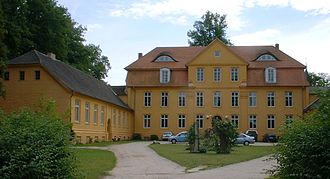Lühburg Castle
The Lühburg Castle in Lühburg is a framed 18th century in the first third mansion , already in the Middle Ages owned by the aristocratic family Bassewitz was. Its baroque style three-wing system is considered to be the oldest of its kind in Mecklenburg .
history
The Lühburg estate and with it the Dalwitz and Prebberede estates were owned by the Bassewitz family as early as the beginning of the 14th century . More than three centuries later, Lühburg was almost completely destroyed during the Thirty Years' War .
From 1725 to 1730 Ludolph Friedrich von Bassewitz had the castle built on the property, which is still preserved today . A main building with two floors and a higher, gable-crowned central wing and two single-storey cavalier houses were built on the side . The historical stone tablet with an inscription installed in the stairwell has also been preserved from the history of the building.
In 1782 or 1783, District Administrator Joachim Ludolph von Bassewitz sold all of his goods around Lühburg. The buyer of Lühburg with Basse and Repnitz in the Gnoien office was master hunter David Splittgerber , who also acquired a gift from God. Only a few years later, the entire property passed to Friedrich Carl Graf von Schlieben in 1788 . The would-be doctor Karl Wächter dedicated his dissertation Sistens Observationvm Medicinalivm Satvram , which was presented in Latin at the University of Rostock in 1793 at the University of Rostock, to the "Viro illvstrissimo generosissimo Carolo comiti de Schlieben / maecenati svo gratiosissimo" , before Wächter briefly practiced in Lühburg.
In 1811 Lühburg, together with Basse and Gottesgabe, became the property of the Countess von Hardenberg, wife of State Minister Count von Fürstenheim , i.e. Caroline Adelheid Christine Julie Eleonore von Hardenberg (1784 – after 1809), eldest daughter of August Wilhelm Karl von Hardenberg .
From 1818 the Mecklenburg State Calendar recorded Johann Christian Wächter as the owner of the Lühburg property. From 1840 the Landdrost Christian Friedrich Anton von Drenckhahn is named as the owner, from 1844 Baron Schimmelpenning von der Oye and from 1849 Carl Friedrich Amand Strömer.
Only in 1858 did Lühburg come back into the possession of the noble family Bassewitz through the purchase of Heinrich Ludwig Graf von Bassewitz-Dallwitz (1831-1911).
At the end of the Second World War , the Bassewitz family was expelled from Lühburg. The buildings were then inhabited by refugees. During this time, the largely culturally and art-historically valuable furnishings on the property disappeared and were even used for heating.
During the GDR era , the top floor of the house burned down in 1966, but it was then rebuilt. Until 1992 the house housed a school, served as the town center, was a community office and cultural space, kept a library and functioned as a restaurant. A cooperative shop of the “ Konsum ” chain and a kindergarten also found temporary accommodation at Gut Lühburg.
In 1992 the "Prof. Dr. Ing. Heinz Steffen “the Lühburg Castle from the community. The house was then extensively restored and refurbished, with the building largely being given its original appearance. Inside, holiday apartments and a ballroom were set up around the same time.
In 2010 Dorothee Calsow, née Countess von Bassewitz, bought the former house of her great-grandparents as a residence for herself and her family. Parts of the building have since been rented out as holiday apartments and for events.
See also
Web links
- Website schloss-luehburg.de
Individual evidence
- ↑ a b c o. V .: History of the estate on the page schloss-luehburg.de [ undated ], last accessed on May 9, 2020
- ^ A b c d Archive for regional studies in the Grand Duchies of Mecklenburg , year 18, Schwerin, published by the Hofbuchdruckerei AW Sandmeyer, 1868, pp. 292, 309; Digitized via Google books
- ↑ a b c d e f g Angelika Halama: Manor in Mecklenburg-Schwerin. Cultural and geographic change from the 19th century to the present (= communications of the Geographical Society in Hamburg , Volume 98) also dissertation 2004 at the University of Hamburg under the title The manors in north-east Mecklenburg-Schwerin in the change from the 19th to the 21st century with special consideration des Raumes Tessin-Gnoien , Stuttgart: Steiner, 2006, ISBN 9783515087803 and ISBN 351508780X , p. 45; Preview over google books
- ↑ Dedication after the title page of the dissertation
- ^ Gustav Willgeroth : Lühburg bei Tessin , in ders .: The Mecklenburg doctors from the oldest times to the present. Collected and edited by Dr. med. A. Blanck 1874, continued by OMed.-R. Dr. Axel Wilhelmi until 1901. Supplemented by genealogical reports and continued up to the present by Gustav Willgerodt , publishing house of the regional office of the Mecklenburg Aerztevereinsbundes, Schwerin 1929, p. 139; Digitized via the Rostock University Library
- ↑ Johann Wolf : History of the family of Hardenberg , Volume 2, Göttingen: printed by JC Baier, 1823, p. 269; Digitized via Google books
- ^ Friedrich Schlie (arrangement): The art and history monuments of the Grand Duchy of Mecklenburg-Schwerin , vol. 1: The district court districts of Rostock, Ribnitz, Sülze-Marlow, Ticino, Laage, Gnoien, Dargun, Neukalen , Schwerin: printing and publishing the Bärensprungschen Hofbuchdruckerei, commissioned by KF Koehler in Leipzig, 1896, p. 494; Preview over google books
Coordinates: 53 ° 58 ′ 49.2 " N , 12 ° 35 ′ 48.2" E
